#nonverbal microaggression
Explore tagged Tumblr posts
Text
Understanding Nonverbal Microaggressions

In our society, communication extends far beyond the words we speak. Nonverbal cues can play a significant role in shaping our interactions and relationships. Nonverbal communication can be just as impactful as verbal communication, and often subtle and seemingly harmless, nonverbal microaggressions can profoundly affect an individual's mental health and well-being.
Microaggressions are every day, verbal, nonverbal, and environmental slights, snubs, or insults, whether intentional or unintentional, which communicate hostile, derogatory, or harmful messages to target persons based solely upon their marginalized group membership. In many cases, these hidden messages may invalidate the group identity or the reality of the targeted individuals, demean them on a personal or group level, communicate they are lesser human beings, suggest they do not belong with the majority group, threaten and intimidate, or relegate them to inferior status and treatment (Sue, 2010). The difference between microaggressions and overt discrimination or macroaggressions is that people who commit microaggressions might not even be aware of them (Nadal, 2020). Microaggressions can impact an individual's mental health because they are so subtle, causing the target to question themselves and their experience. While microaggressions are generally discussed from the perspective of race and racism, any marginalized group in society may become a target (Sue, 2012).
Microaggressions may include subtle verbal insults or seemingly innocuous nonverbal cues. Here are some examples of nonverbal microaggressions:
Facial Expressions:
Facial expressions are a powerful means of communication, capable of conveying emotions and attitudes. However, they can also be used as a tool for nonverbal microaggressions. For instance, a dismissive eye roll or a raised eyebrow when someone is expressing their opinion can subtly undermine their contribution, making them feel invalidated or ignored (Epler, 2021).
Body Language:
Body language speaks volumes, sometimes even louder than words. Nonverbal microaggressions can manifest through various forms of body language, such as crossed arms, turning away, or avoiding eye contact. These actions can signal discomfort, disapproval, or a lack of interest, leaving the recipient feeling unwelcome or disregarded (Epler, 2021).
Personal Space Invasion:
Respecting personal boundaries is essential for maintaining healthy interactions. Invading someone's personal space can be a nonverbal microaggression, often signaling a disregard for their comfort. It could be leaning in too closely, invading their personal bubble, or persistently standing too close to them despite visible signs of discomfort. Such actions can cause anxiety and can be particularly triggering for individuals with a history of trauma.
Tone of Voice:
While nonverbal, tone of voice holds significant weight in communication. Inflicting a sarcastic, condescending, or mocking tone can be a nonverbal microaggression. This subtle undermining tactic can make individuals doubt their capabilities, erode self-confidence, and contribute to feelings of inadequacy.
Ignoring or Interrupting:
Being ignored or consistently interrupted sends a powerful nonverbal message of marginalization and insignificance. This form of microaggression suggests that one's voice or contributions are not valued, leading to feelings of frustration, exclusion, and a diminished sense of self-worth.
Non-Inclusive Gestures:
Certain nonverbal gestures can unintentionally exclude or isolate others. For example, forming exclusive cliques through closed-off body language or engaging in inside jokes that others do not understand can make individuals feel left out and socially ostracized. It is important to be mindful of the inclusivity of our nonverbal behavior and strive to create an environment that embraces diversity.
Microaggressions in Physical Contact:
Physical touch is a potent form of nonverbal communication, and inappropriate or unwelcome contact can constitute a microaggression. Touching someone's hair without consent, invading their personal space, or engaging in unwanted physical contact disregards people's boundaries and can lead to discomfort, anxiety, and a sense of violation.
Nonverbal microaggressions often go unnoticed or dismissed as insignificant. However, their impact on an individual's mental health and well-being should not be underestimated. By recognizing and addressing these subtle forms of communication, we can foster an environment that promotes inclusivity, empathy, and respect. As we strive for greater awareness, it is essential to engage in open conversations about nonverbal microaggressions. Educating ourselves and others about their existence, impact, and alternatives empowers individuals to challenge and change harmful behaviors. It is also important to practice empathic listening, opening ourselves up to other perspectives that may differ from our own (Epler, 2021). Together, we can work toward creating a more thoughtful, inclusive society that actively listens to the concerns of others.
Check out some of the resources of Nonverbal Microaggressions here.
0 notes
Text
…something been in draft for while:
idk how say this exactly but often like. use what look like binary clear cut dichotomy that have set definition this is this that is that. because oftentimes call “cake” “cake” instead of “flour milk egg baking powder salt etc etc” that kind language faster simplier and nuance can easily put word count 10k+. and. with language communication disabilities not always able translate all nuance into tangible word on paper/screen/type sometimes have to call something with imperfect blanket word. and then you find out other people not really hold as much nuance as you & still simplify your nuance into something binary this this that that
but reality rarely that binary— say on here that nonverbal mean not mouth speak at all all time & semiverbal is struggle all time but can mouth speak some & verbal but actually more nuanced than that like some severely apraxic people who mouth do say thing but not in their control not what they want say & they still call self nonspeaking because it not intentional meaningful speech; or someone labeled nonverbal who actually do commmunicate with mouth words just not full sentence & not full clear pronounce but still labeled nonverbal anyway as almost like microaggression of not recognize their single or two word mouth word phrase as valid enough communication worth listen to; or someone with echolalia that not mean anything with it (vs someone with echolalia that is use echolalia as communication (think gestalts, etc)); or some research showing even able say 1-2 words more ability than those with 0 word; or research debate about where minimally verbal end is it 20 words 30 words 50 words
when combat “go nonverbal” crowd often say there is clear cut about what nonverbal and what isn’t and yeah there is clear cut but also is there
many not ready for this level muddiness & nuance because some take bring nuance as invite to say like “i nonverbal but can still (intentionally) mouth speak” or gateway to claim nonverbality as if fun new identity collect instead of some complicated complex experience with mixed emotion but often some level of grief at some point that get lot targeted awful ableism & discrimination like denied education refuse accommodation like IEP or put in segregated classroom without even consider accommodation in general ed to isolate away from peers n not actual to help nonverbal person where they best thrive, or secluded or restrained, or denied healthcare, denied communication, which all still happen now btw it still common now it not rare obsolete it majority still
which make me feel like this image
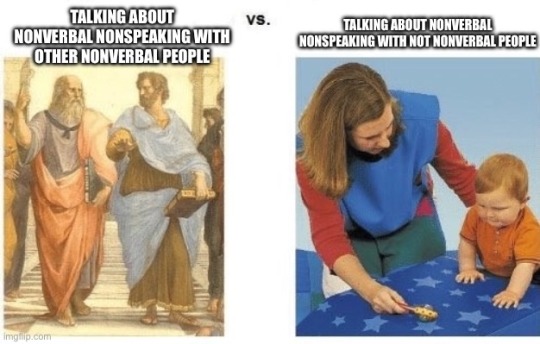
[id: meme. left side is philosophers (school of athens painting) with caption “talking about nonverbal nonspeaking with other nonverbal people”. middle say “vs”. right side image is parent guiding infant to look play at toy and captioned “talking about nonverbal nonspeaking with not nonverbal people. end id]
because sometimes really is that but also even this is binary. thinking about how some motor nonspeaking people without intellectual disability who language okay say their mind intact that they not stupid thus deserve education and not deserve abuse and throw people with ID & language impairment. or how nonverbal nonspeaking from autism so different from (but so similar to) from motor apraxia from cerebral palsy from intellectual disability from genetic or chromosomal disorders from stroke from TBI from aphasia from vocal cord dysfunction from dementia from from from… how talking to someone nonspeaking from primarily motor reasons without cognitive intellectual language disabilities as someone nonverbal because high level autism cognitive language disabilities, we not guarantee understand eachother experience, same with talk someone from acquired things vs mine neurodevelopmental, how what i say about nonverbal here may not apply to someone who not speak not because autism etc
but “if words so meaningless if experiences so boundless let abolish all” not helpful because for all kind way be nonverbal there experiences that 100% not nonverbal there experiences so different from nonverbal “not able meaningfully intentionally speak all the time” for every meaningless there meaningful reason nonverbal people use nonverbal and deserve word “nonverbal” for ourselves and how this difference in experience is intracommunity issue issue within nonverbal nonspeaking community something we have to grapple with and not invitation for people outside to talk about how “if nonverbal so wide, drawing line at going nonverbal & say that isn’t nonverbal is ridiculous and gatekeep” because as much vast different experience there is reason why there community why there this word we all call ourselves and. not one. of the reason is we can slide in and out of not speak and speak daily or weekly or monthly or regularly. there still common theme to what we call nonverbal despite different
wide word isn’t “functionally useless” it just you not know how n when use it
& this conversation not just apply to nonverbal but many other words n other things as well
138 notes
·
View notes
Text
Ultimate pet peeve is fanfic writers who make their favourite characters disabled for the aesthetic but don't carry through with the disability.
I've read so many where a character is or becomes blind, but something happens and their sight is magically restored!
Or ones where a character is deafened temporarily because the author wants to write the angst of them becoming deaf but doesn't actually want to deal with the consequences.
Or a character is deafened but don't worry because everyone in this universe already knows sign language. Or everyone they ever interact with learns it for them and becomes fluent within a few weeks.
Or the disabled character is violently beaten up by a group of bullies for just being disabled. So that their love interest can rush to their side and comfort them.
Or someone loses a limb but don't worry the healthcare system is very good and they quickly get a prosthetic without talk of expenses.
Or nonverbal characters who have a perfectly normal life because they can whisper things to their love interest and they're infantilised.
And their insecurities are immediately cured when their love interest tells them they are still beautiful.
The amount of times I read fanfics where the character becomes blind but they find a long stick and instinctively know how to use a cane.
Where are the fanfictions where the disabled character experiences microaggressions? Able-bodied people who write this shit don't actually understand the subtle ableism and eugenicist ideas that weigh us down every day.
And it's never shit about hidden disabilities or anything that could be considered embarrassing, because that's not appealing.
People love writing their characters with disabilities but never actually write the problems they come with.
22 notes
·
View notes
Text
Small Words, Big Impact: How Microaggressions Affect Daily Communication | Relationships News
Microaggression in communication is defined as subtle, often inadvertent verbal or nonverbal behaviours that send negative, aggressive, or disparaging messages to others, particularly marginalised individuals or groups. These seemingly simple gestures have the potential to reinforce preconceptions, create an uncomfortable workplace, and perpetuate discrimination. The negative impacts of these…
0 notes
Text
Understanding Microaggressions in Nursing
Credit: Texas Nurses Association Cource: Texas Nurses Association, Posted by Gabi Nintunze, February 20, 2024 Microaggressions can be defined as “the everyday verbal, nonverbal, and environmental slights, snubs, or insults, whether intentional or unintentional, which communicate hostile, derogatory, or negative messages to target persons based solely upon their marginalized group…

View On WordPress
#ageism#discrimination#marginalization#micro insult#microaggression#microassault#microinvalidation#nurse#Nursing#racism#sexism
0 notes
Text
Microaggressions: Understanding the Harmful Impact of Subtle Discrimination
The theory of microaggression is a concept that has gained increasing attention in recent years, particularly in the field of social psychology. Microaggressions are defined as subtle, often unintentional acts or comments that communicate hostility or derogation towards marginalized groups. These acts can be perpetrated through verbal or nonverbal means and can be expressed in a variety of…

View On WordPress
0 notes
Text
Pierce employed the term [“microaggression”] to describe the constant verbal and nonverbal abuse racist White people unleash on Black people wherever we go, day after day. A White woman grabs her purse when a Black person sits next to her. The seat next to a Black person stays empty on a crowded bus. A White woman calls the cops at the sight of Black people barbecuing in the park. White people telling us that our firmness is anger or that our practiced talents are natural. Mistaking us for the only other Black person around. Calling the cops on our children for selling lemonade on the street. Butchering Ebonics for sport. Assuming we are the help. Assuming the help isn’t brilliant. Asking us questions about the entire Black race. Not giving us the benefit of the doubt. Calling the cops on us for running down the street.
I do not use “microaggression” anymore. I detest the post-racial platform that supported its sudden popularity. I detest its component parts—“micro” and “aggression.” A persistent daily low hum of racist abuse is not minor. I use the term “abuse” because aggression is not as exacting a term. Abuse accurately describes the action and its effects on people: distress, anger, worry, depression, anxiety, pain, fatigue, and suicide.
Ibram X. Kendi, How To Be An Antiracist
3 notes
·
View notes
Link
Since moving to university, I’ve had to explain autistic spectrum disorder (ASD, formerly two separate categories consisting of “Asperger’s syndrome” and “autism��) to nearly every friend I’ve made. It makes sense; public exposure to neurodivergence, let alone ASD specifically, is sparse. Though representation is rising with shows like Atypical and Young Sheldon, autistic characters are usually men, and almost invariably white. ASD has a plethora of variables, and factors like gender and race can vastly impact the experiences of autistic people. Yet, in television and movies, only these specific presentations and circumstances are illustrated.
Most children with ASD are distinctly aware that they are different from their peers, and I was no exception. With literally no exposure to people like me, I grew up thinking that I was, neurologically, entirely alone. Even when exposed to autistic characters before I learned about my diagnosis in adolescence, it didn’t click that they resembled me; they were all (considerably older) men. Only their mindsets, abilities, and interactions with their surroundings were being portrayed. And as these were the only public, accessible depictions of ASD, I often caught myself analysing my behaviour and comparing it to theirs. I frequently questioned the legitimacy of my autism’s manifestation as a result of these differences.
Autistic experiences vary by gender, too. Social interaction amongst girls, for instance, is significantly more dependent on subtlety and nonverbal communication than it is amongst boys. As it happens, autistic people find these things damn near impossible. Social expectations are also generally far higher for girls. Consequently, I found it much harder to make friends with other women and successfully interpret their exasperation. This is immensely common amongst autistic girls, but with no portrayal of this in mainstream media, I was isolated, and came to the conclusion that I was simply socially defective.
This isolation is amplified for autistic people of colour as they further diverge from their white, neurotypical peers. They often find themselves sacrificing part of their culture. I, for instance, didn’t speak for years; the health visitor suggested that being raised in Urdu alongside English was slowing me down, and resultantly, I never learned it. Furthermore, understanding of neurodivergence varies vastly across cultures, often generating significant obstacles to those trying to learn about ASD and seeking diagnosis. Autistic people of colour also face conscious and subconscious racism, which means that these differences are more likely to be viewed negatively. A white person who struggles socially is typically deemed “shy” or “withdrawn,” while I’ve repeatedly seen people of colour with exactly the same traits branded as “disagreeable” or “rude”. Autistic difficulty in deciphering unspoken dialogues, like racist microaggressions, makes it significantly harder for them to discern how much of the animosity they face is discriminatory.
read more
28 notes
·
View notes
Text
Licensed Psychologist Dr. Nia
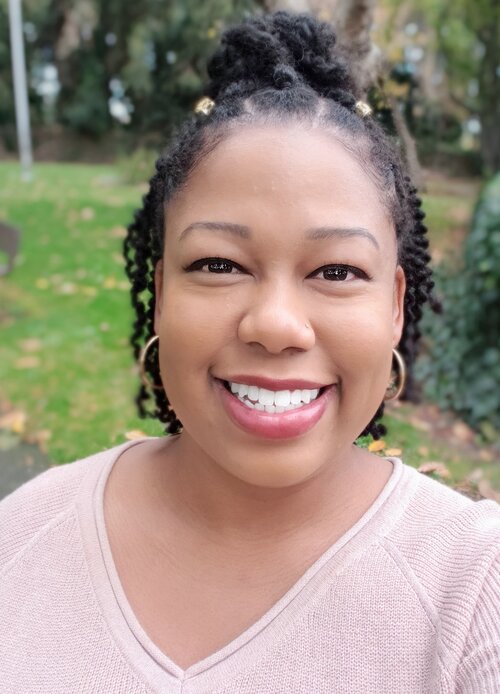
CONNECTION * AFFIRMATION * EMPOWERMENT
Therapy can help you discover the tools within you to write your own story and reach the healing you deserve.
Hi, I’m Dr. Nia (she/her/hers) and I want to congratulate you on taking the first steps towards reaching out for support. Although I am a licensed psychologist, I believe you already have within you the tools that can support your healing journey. I honor the experiences and resiliency that have brought you this far. My goal as a therapist is to create a space where you feel safe and empowered to explore what your own healing may look like. We may practice using new words to describe how you are feeling inside, creating a shared language for your experience and paying close attention. Ultimately, you are in control and I am a guide.
I feel particularly called to work with people of color, women and girls, LGBTQ+ folks, students and young professionals, and those whose identities contribute to difficulties with feeling accepted or valued.
CULTIVATING COMMUNITY AND HEALING
I consider the impact of family, cultural, or societal messages that can interfere with your journey towards wellness and self-love. As a Black woman, I understand the pressure we can feel as we take care of others, sometimes at the cost of our own needs. I am passionate about working with other Black and Brown women who may experience these difficulties as they navigate the everyday demands of work, school, family obligations, and romantic relationships. I support clients to unlearn old strategies that may be self-defeating and learn new ways of coping and being in relationships with themselves and others.
CREATING SAFETY, TRUST, AND SOMATIC HEALING
Drawing on my extensive training in treating trauma, I value creating a space where clients feel emotionally safe. I utilize an authentic and empathic therapeutic style to create a space where clients feel seen, heard, and valued. I model transparency so clients can understand the reasoning behind therapeutic interventions and feel empowered to make informed choices about treatment. When working with trauma, I integrate Psychodynamic, Cognitive-Behavioral Therapy (CBT), Dialectical Behavior Therapy (DBT), Interpersonal Therapy, Motivational Interviewing, and Somatic interventions. I integrate somatic work because our experiences stay with us, not just mentally and emotionally, but physically. Our bodies hold a lot of wisdom about where healing is needed. I utilize body-based interventions to encourage you to pay attention to not only your thoughts and feelings but bodily sensations.This can help you develop trust in yourself to understand what you might be needing in the present moment.
BLENDING CLINICAL EXPERTISE AND CLIENT-CENTERED VALUES
I draw heavily from Psychodynamic, Relational, and Somatic approaches within a multicultural and trauma-informed framework. I collaborate with clients to uncover hidden conflicts while also acknowledging the external pressures that may keep them feeling ‘stuck.’ I can support you in processing childhood trauma, setting better boundaries, increasing coping skills, developing self-compassion, combatting perfectionism, managing stress, and improving work-life balance. Because I know we are often racing to check things off our to-do list, I will focus on slowing down and paying attention to the physical sensations that arise during sessions to increase awareness of what you might be needing in the present moment.
HELPING CHILDREN THRIVE AT SCHOOL AND AT PLAY
Children are naturally curious and still learning the necessary skills for being successful in an adult world.They can feel worried, sad, and angry, but often do not have the language to express these big emotions. Parents and caregivers are an essential part of child therapy and I will work collaboratively with you to best support your child. I use a play therapy relational approach with both verbal and nonverbal interventions (art, movement, therapeutic games, sandtray). This approach allows children to develop a sense of trust and express their emotions in a safe, contained way. Play therapy within the context of a trusting therapeutic relationship can help identify the unmet need underlying a child’s problematic behavior and support parents and caregivers in responding in healthier ways.
NAVIGATING LIFE’S UPS AND DOWNS WITH TEENS
If you are a parent or caregiver who is at your wit’s end dealing with your teen, please know you are not alone in this struggle. Although parent-teen conflict is common in this age group, there is hope for getting through to your teen and improving your ability to connect with them. I have extensive experience treating teens who are dealing with anxiety, depression, trauma/abuse, or have trouble fitting in with their peers. They may also struggle with low self-esteem and figuring out who they are with respect to their identity. I am particularly interested in working with teens who have suicidal thinking or engage in self-harm and other risky behaviors. I use a combination of talk therapy, play therapy, family systems, and somatic approaches to help teens with managing their symptoms, increasing their ability to cope with stressors, and improve their relationships. In my work with teens, I honor their developing independence while supporting their connections to the people who truly care about them.
SUPPORTING STUDENTS, YOUNG PROFESSIONALS, AND ADULTS CREATE BALANCE
It can often feel like there aren’t enough hours in a day. Whether you are in school, working, or both, you are likely dealing with multiple demands while trying to stay on top of everything you need to accomplish. The thought of taking time for yourself makes you feel selfish so you struggle to say “no” to outside obligations. Utilizing a blend of somatic, holistic, and relational approaches, I help clients to develop healthy boundaries while nurturing the relationships that are most important.
HELPING COUPLES AND FAMILIES RECONNECT AND FIND JOY
It’s common for there to be conflict in couples and among family members. Sometimes, these difficulties are impacted by patterns of relating to each other that were developed earlier in life. These patterns can often span generations and be difficult to change. What’s important is that even after a rupture, you can repair the relationship. Using psychodynamic, family systems, and relational approaches, I can support you in repairing those ruptures and improving the quality of your relationships.
I utilize a holistic approach in couples and family work that integrates techniques such as Emotion-Focused Therapy (EFT), Somatic Therapy, and Family Systems interventions. These approaches help you recognize harmful or dysfunctional patterns and rework them while paying attention to the feelings, thoughts, memories, and bodily sensations that arise during interactions with each other. Using this new knowledge, couples and family members can improve their communication, have a renewed sense of attachment, and rediscover joy in each other.
SPECIALTIES AND INTERESTS
Healing for Black and Brown girls and women
Treating trauma and attachment difficulties
Adjustment challenges and dealing with life transitions
Supporting teens with the transition to adulthood
Body image and self-esteem concerns
Coping with depression and anxiety
Healing from grief and loss
Foster care youth and adoption
Acculturation stress
Supporting children and teens of divorce
Helping separated and divorced families with co-parenting
Improving family connection and communication
Reducing self-harm and risky behaviors in teens
Identity exploration
Treating psychosis and mood disorders
Working with parents of children with ADHD
Healing from childhood abuse and inter-generational trauma
Healing from racial trauma and microaggressions
Increasing self-worth and setting boundaries
Improving self-understanding and self-compassion
Managing school and work stress
Women of color issues in school or the workplace
Supporting families with communication challenges
Couples and families navigating trust issues or attachment ruptures
Interracial couples and cross-cultural relationships
CREDENTIALS
Licensed Clinical Psychologist, PSY31472
Ph.D. in Clinical Psychology from the California School of Professional Psychology (CSPP) at Alliant International University.
M.A. in Clinical Psychology from Adelphi University
B.A. in Psychology, minor in Women’s Studies, St. John’s University
TRAINING
Healing Trauma in Children with Play (2019)
Working with Latinx Families (2019)
Dominant and Subjugated Narratives: The Culturally Sensitive Assessment (2019)
Early Childhood Mental Health: Integrating and Assessing Complex Trauma with young children and their families (2018)
Project WHAT- Working with children of incarcerated parents (2018)
CARMA Foundations for Working With Complex Trauma (2018)
Gender & Culturally Responsive Mental Health Practice with African American Male Youth (2017)
Engaging foster youth in Treatment (2017)
Expressive Arts and Drama Therapy (2017)
Trauma-informed Systems Training (2017)
Radical Healing (2017)
Integrative Treatment of Complex Trauma-Adolescents (2017)
LEARN MORE ABOUT DR. NIA
Hear about her views on healing, therapy and more!
READY TO WORK WITH DR. NIA
Contact us today!
1 note
·
View note
Text
Why you need to stop asking these questions and learn about racial microaggression
Why you need to stop asking these questions and learn about racial microaggression
*This post contains affiliate links
Microaggression are everyday verbal, non-verbal and environmental snubs or insults. This isn’t necessarily intentional, however it communicates hostile, derogatory messages to target a person based entirely on their group, particularly their racial group. The result is that it can invalidate their identity and communicate they are a lesser being. This…
View On WordPress
#black lives matter#blm#books on microaggression#examples of microaggression#is microaggression on purpose?#macroaggression#microaggression#microassult#microinsult#microinvalidation#nonverbal microaggression#systemic racism#what is microaggression
0 notes
Text

Race is the categorization of the human population based on shared physical characteristics common among people of shared ancestry or social qualities into groups generally distinguishable within an allotted society. During the 18th century, the use of race was commonly used in scientific fields such as physical anthropology. The picture above refers to race because it shows the distinguishable groups of people.

Phenotypes are the physical characteristics or traits of an organism's physical appearance such as height, skin, and eye color. Phenotypes are heavily influenced by the environmental effect the individual is in, rather than the genetic effect. The image above represents phenotype because the woman I'm the picture, Kylie Jenner wasn't born with some of her physical features.

Jim Crow laws are racial segregation and discrimination enforced by laws in the southern United States. These laws were set in 1877, during the reconstruction, until the 1950s, during the civil rights movement. The image shows an example of how Jim Crow laws were set up.

Microaggression is more than just insensitive comments; it is verbal and nonverbal snub-like actions, and antagonistic comments, whether intended or. unintended, that convey derogatory or negative messages to target someone based exclusively upon their ethnicity, gender, sexual orientation, or religion.

Miscegenation is the crossbreeding of people who are constituents of different ethnicities. The term came to be associated with laws that prohibited interracial relationships, which were known as anti-miscegenation laws. Interracial relationships were not tolerated by a majority of Americans in general in the 19th century. Interracial couples received a lot of hate until the 1990s.

Institutional racism is habits of discrimination that are a form of racism that is entrenched in the laws and regulations of an organization. Institutional racism categorized groups to unfairly distribute the societal goods and resources, this was a disadvantage to many groups. This became the distinct focus of the United States scholarly investigation in the 1980s.
Source: https://www.britannica.com/
(My fieldwork isn't late, it got deleted)
0 notes
Text
Microaggressions - verbal, nonverbal, or behavioral taunts used frequently that target an individual or group of individuals based on their background.
The information I've copied provides instances of how microaggressions might look or sound, in addition to actual accounts of what has actually occurred to individuals. This, in my opinion, demonstrates how many individuals who are African-American are often encouraged to disregard these remarks or behaviors, or even to avoid letting them affect them. It is very clear that racism still disadvantages people of color and contributes to many of the issues we face today in the same manner that it did years ago.
Institutional Racism - also known as systemic racism, is a type of racial discrimination that is established in a society's laws and rules.

This photo highlights five areas where systemic racism occurs. As far as I know, housing is one of the areas that many individuals of color have a hard time with. There are also 5 subcategories with definitions of what they are.
Intersectionality - how elements like race, gender, and class influence people's life chances and social behaviors of stratification.
youtube
In this video, it is addressed how racial and gender discrimination may affect black women. Individuals with disabilities, individuals from various religious backgrounds, people who have diverse looks or who speak different languages may all fall under the umbrella of intersectionality. Many people don't constantly consider their identities. It's possible that individuals won't have to worry about identity thoughts based on what they have going on in life.
Jim Crow - laws put into place after the Civil War to officially enforce segregation, especially in the South after the abolition of slavery.

This image essentially speaks for itself. It demonstrates the measures POC took to make their voices heard. The majority of these events took place without violence.
Phenotype - the set of common characteristics that make up an individual and are the product of their genetics.
This website offers a brief description of genetic makeup & phenotypes. It also contends that environmental factors have a greater influence on genotypes than do genetic ones. This may have an impact on numerous minority groups. Everything is not exactly as it seems.
Genotype - the genetic makeup of an individual.
A genotype's definition and origin are explained in this video. Many people today may not be aware that genotypes differ across individuals. Every individual is one-of-a-kind and has their own unique genetic makeup. People might not be aware that parents are responsible for the characteristics their children are born with. Others in society may categorize or stereotype how they think or feel people should look.
0 notes
Text
Chapter 5 Field Work Racism

Racism is prejudice, discrimination, or antagonism directed against a person or people on the basis of their membership in a particular racial or ethnic group, typically one that is a minority or marginalized. This image shows racism because it is telling black people to wait in a specific area away from white people. Whoever made this sign wants black and whites to be separated because the two “races” are not equal.

White privilege, or white skin privilege, is the societal privilege that benefits white people over non-white people in some societies, particularly if they are otherwise under the same social, political, or economic circumstances. In spite of the fact that they both have a criminal history, the white man in this image is given a job but the black man is not. The man on the left is more likely to get hired due of his race than other people because of his criminal record.

A biracial or multiracial person is categorized as belonging to the lowest-ranking racial group in terms of social standing by hypodescent, also known as the one drop rule. If you're black and white, black and Asian, white and Mexican, etc., you can employ the one-drop rule. This image demonstrates how you can no longer be considered a member of one race after mixing with another. You can see that the white figure vanishes as the chain lengthens.

Everyday verbal, nonverbal, and environmental slights, snubs, or insults—whether deliberate or not—are referred to as microaggressions. Unintentionally engage in aggressive, disparaging, or hostile communication with target individuals based only on their ethnicity or culture. They are enquiring about the woman in the middle of the image above since she is an Asian and may speak English. Additionally, they are requesting an American doctor for the individual on the right since he appears to be of Hispanic descent.

Understanding how various biases and forms of discrimination may impact an individual, a group of individuals, or a society issue is known as intersectionality. The idea of intersectionality highlights a number of benefits and drawbacks, including those related to gender, color, ethnicity, sexual orientation, religion, etc. The image above illustrates intersectionality since any one of these factors, no matter how minor or significant, might explain why someone is the target of discrimination.

Miscegenation is the blending or settling of individuals from various races. The man and lady in the picture above are of different ethnicities, and the child is a mixture of their races. Even if some individuals dislike miscegenation, it still occurs.
0 notes
Text
CH. 5 FIELD WORK
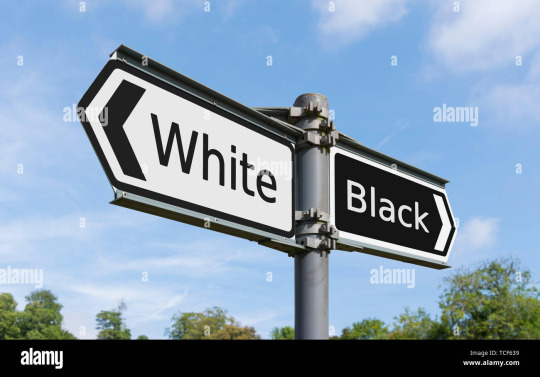
Racism is discrimination against one or multiple races. Racism can be shown by a person's actions or choice of words. This picture displays racism because the sign is telling blacks to go to one side and whites to go to another. Whoever made this sign wants black and whites to be separated because the two “races” are not equal.
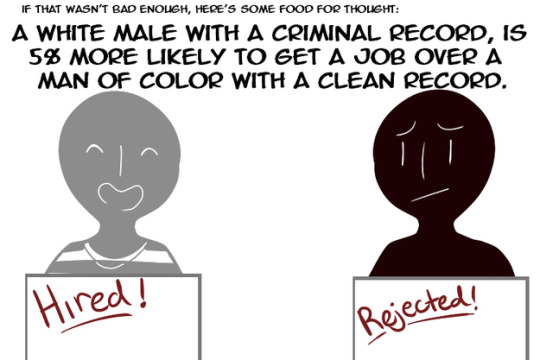
White privilege is the multitude of social and economic benefits that white people enjoy because of their race in a society that is characterized by racial inequality. White privilege is shown more and more every day, especially during everyday tasks. This picture shows how a white man is given a job, but the black man isn’t even though they both have a criminal record. Most jobs won’t hire you because of a criminal record, but in this case, a man on the left is more likely to get the job because he is white.
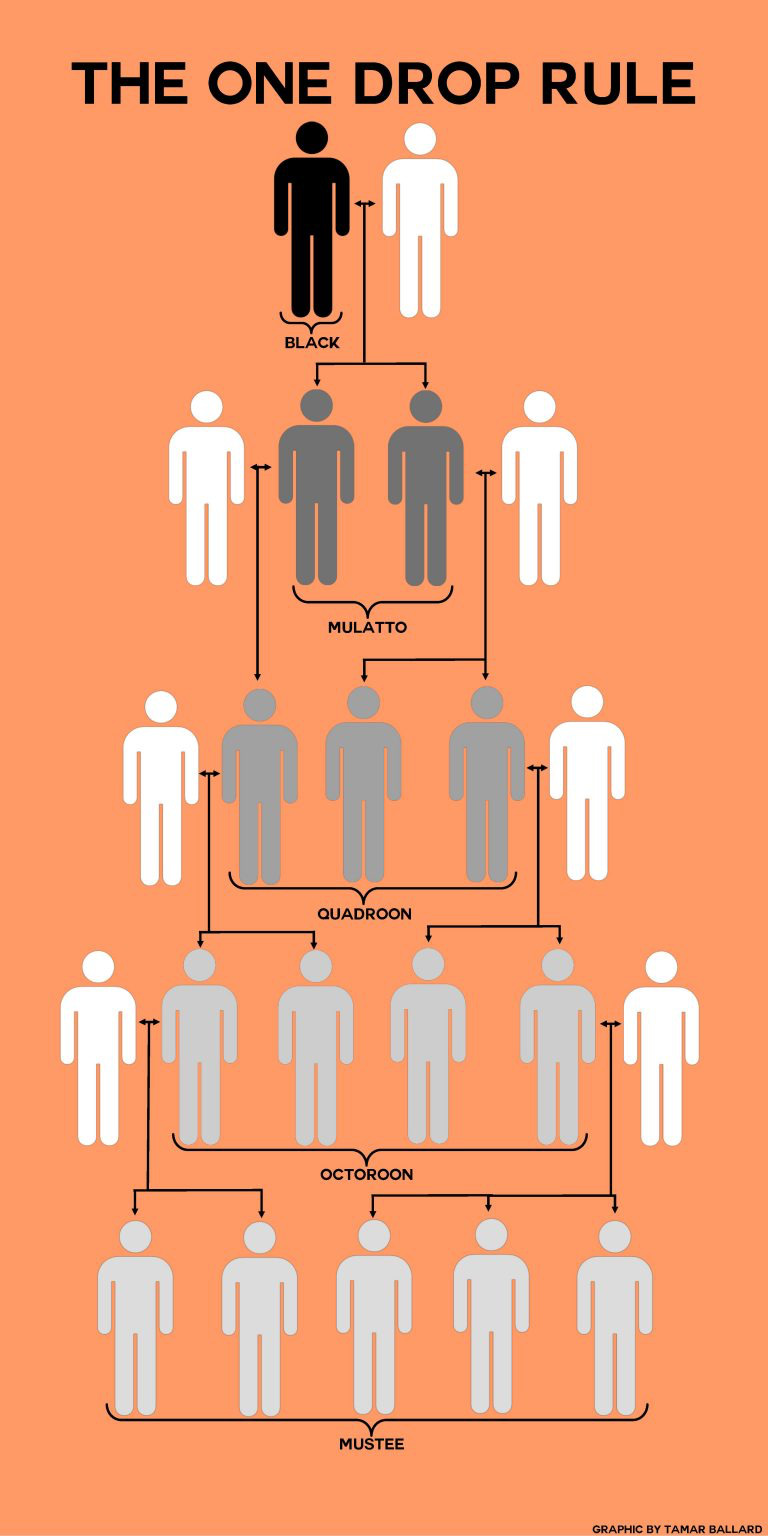
Hypodescent, also known as the one drop rule is the designation or classification of a biracial or multiracial person as belonging to the lowest-ranking racial group in terms of social status. The one-drop rule can be used if you are black and white, black and Asian, white and Mexican, etc. This picture shows that once you are mixed with a different race, you are not classified as one anymore. As the chain gets longer and longer, you can see that the white figure disappears.
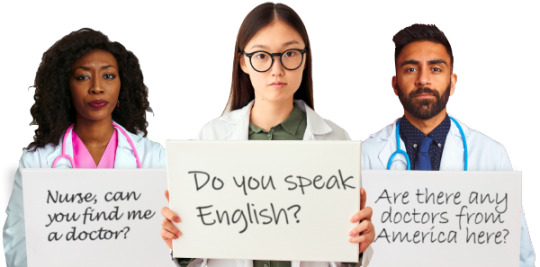
Microaggression is the everyday verbal, nonverbal, and environmental slights, snubs, or insults—whether intentional or not. Unintentionally communicate with target individuals in a hostile, derogatory, or hostile manner based only on their race or culture. In the picture above, they are asking if the woman in the middle speaks English because she is part of Asian culture. Also, they are asking the man on the right if he can get an American doctor because he looks to be of Hispanic origin.

Intersectionality is a way of understanding how different types of bias and discrimination might affect a person, a group of people, or a social issue. The concept of intersectionality reveals several advantages and disadvantages such as gender, race, ethnicity, sexual orientation, religion, etc. Intersectionality is shown in the picture above because all of these things can determine why someone is being discriminated against, no matter how big or small it is.
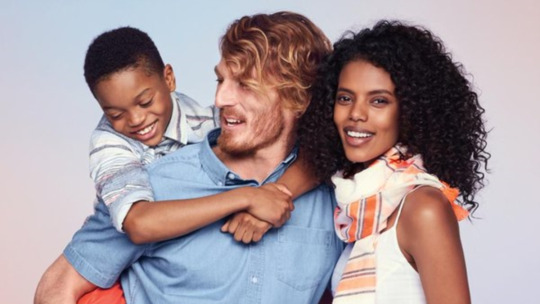
Miscegenation is the union or settlement of people from different races. In the picture above the woman and the man are of different races and the child is a mix of those races. Miscegenation is something that some people don't like, but it happens anyway.
0 notes
Text
Diversity and Inclusion: Glossary of Terms
Diversity is a hot topic right now. Before you dive into diversity and inclusion conversations, it’s important to understand the terms and words you use in these crucial conversations. To help, we’ve provided you with this glossary of terms.
Access
Creating the necessary conditions so that individuals and organizations desiring to, and who are eligible to, use services, facilities, programs, and employment opportunities.
Ally
A person of one social identity group who stands up in support of members of another group, typically a member of dominant identity advocating and supporting a marginalized group.
Bias
Prejudice in favor of or against one thing, person, or group compared with another, usually in a way that’s considered to be unfair. Biases may be held by an individual, group, or institution and can have negative or positive consequences.
Unconscious bias is an unconscious implicit association, whether about people, places, or situations, which are often based on mistaken, inaccurate, or incomplete information and include the personal histories we bring to the situation.
Culture
The behaviors, beliefs, values, and symbols are passed along by communication and imitation.
Disability
A physical, mental or cognitive impairment or condition that requires special accommodations to ensure programmatic and physical access.
Diversity
Psychological, physical, and social differences that occur among any and all individuals; including but not limited to race, color, ethnicity, nationality, religion, socioeconomic status, veteran status, education, marital status, language, age, gender, gender expression, gender identity, sexual orientation, mental or physical ability, genetic information, and learning styles. A diverse group, community, or organization is one in which a variety of social and cultural characteristics exist.
Emotional Tax
The combination of being on guard to protect against bias, feeling different at work because of gender, race, and/or ethnicity, and the associated effects on health, well-being, and ability to thrive at work.
Equality
Treating everyone the same way, often while assuming that everyone also starts out on equal footing or with the same opportunities.
Equity
Working toward fair outcomes for people or groups by treating them in ways that address their unique advantages or barriers.
Ethnicity
A social construct which divides people into smaller social groups based on characteristics such as values, behavioral patterns, language, political and economic interests, history, and ancestral geographical base.
Inclusion
The act of creating involvement, environments, and empowerment in which any individual or group can be and feel welcomed, respected, supported, and valued to fully participate. An inclusive and welcoming climate with equal access to opportunities and resources embraces differences and offers respect in words and actions for all people.
Intersectionality
The intertwining of social identities such as gender, race, ethnicity, social class, religion, sexual orientation, and/or gender identity, can result in unique experiences, opportunities, and barriers.
Marginalization
Treatment of a person, group, or concept as insignificant or pervasive places them outside of the mainstream society.
Microaggressions
Intentional or unintentional verbal, nonverbal or environmental slights/insults that communicate hostile, derogatory, or negative messages to people based upon their marginalized group. Also known as Subtle Acts of Exclusion (SAE).
Multiculturalism
The practice of acknowledging and respecting the various cultures, religions, languages, social equity, races, ethnicities, attitudes, and opinions within an environment.
Neurodiversity
The concept is that there is diversity in how people’s brains are wired and work and that neurological differences should be valued in the same way we value any other human variation.
Power
Ability to control, coerce or influence people based on privileged identities. Power may be positional and provide access to social, political, and economic resources.
Privilege
Any unearned benefit, right, or advantage one receives in society by nature of their identities.
Race
A social construct that artificially divides people into distinct groups based on characteristics such as physical appearance, ancestral heritage, cultural affiliation, cultural history, ethnic classification, and the political needs of a society at a given period of time.
Ready to talk about diversity and inclusion? Start by knowing and learning these diversity terms. Then practice, practice, practice. Practice makes conversations substantially more relaxed and less daunting!
Want to learn more about diversity and inclusion? Let’s share experiences. Leave a comment below, send us an email, or find me on Twitter.
References
https://www.catalyst.org/2019/05/30/12-diversity-inclusion-terms-you-need-to-know/
https://uh.edu/cdi/diversity_education/resources/pdf/terms.pdf
https://www.diversityresources.com/diversity-terms/
https://diversity.ucsf.edu/resources/unconscious-bias
Subscribe To Our Newsletter
#d&i strategic plan#diversity equity and inclusion strategic plan#diversity equity and inclusion plan#strategic plan for diversity and inclusion#strategic plan for diversity equity and inclusion#strategic plan for diversity equity inclusion
0 notes
Text
Chapter 5 Fieldwork
Individual Racism
1. Personal prejudiced beliefs and discriminatory actions based on race.
https://www.nytimes.com/video/nyregion/100000006654178/rosedale-documentary-where-are-they-now.html?action=click>ype=vhs&version=vhs-heading&module=vhs®ion=title-area&cview=true&t=5
The Racism is Rosedale documentary exemplifies individual racism by showcasing how the white people especially the white children in Rosedale, a Queens, New York neighborhood, treated the black children just for riding their bikes through the city. They called the children racial slurs, threw rocks, and were just plain ignorant because they were black. Some kids even went far enough to call the black children racial slurs.
Microaggressions
2. Common, everyday verbal or behavioral indignities and slights that communicate hostile, derogatory, and negative messages about someone's race, gender, sexual orientation or religion.

Microaggressions are slight hostile comments or even nonverbal insults made intentionally or not intentionally that can be hostile or derogatory. This image showcases a comment made to this black girl that is very derogatory mentioning how even though she’s black that she acts like a race, which is not possible. Not all of one race acts the same. As quoted by Darius Melton in “Opinion: Stop Telling Black People They “Act White” .... “ Race doesn’t dictate behavior, and you can’t tell the color of someone’s character just by examining the color of their skin. I like to believe that most people understand this concept and that the “acting white” sentiment isn’t rooted in malicious intent, but that being said, it still doesn’t come off great the more you think about what’s being implied.”
Racialization
3. The process of categorizing, differentiating, and attributing a particular racial character to a person or group of people.

For example, here is Martin Lawrence dressed as his infamous character Sheneheh Jenkins on his sitcom Martin. Sheneheh is an example of racialization because he is portraying the stereotype around Black Women. This stereotype portrays black women as loud , ignorant , uneducated and many other bad traits that are highly offensive.
Miscegenation
4. A demeaning historical term for interracial marriage.

The image here is of Tamera Mowry-Housley and her husband Adam Housley. For example , Tamera is a twin to Tia Mowry-Hardict and is deemed “less black” in comparison to Tia because she married a white man as while Tia is married to a black man. A lot of controversy and backlash has come to Tamera for simply being married to her husband.
Jim Crow
5. Laws implemented after the U.S. Civil War to enforce segregation legally, particularly in the South, after the end of slavery.

Racial Ideology
6. A set of popular ideas about race that allows the discriminatory behaviors of individuals and institutions to seem reasonable, rational, and normal.

0 notes